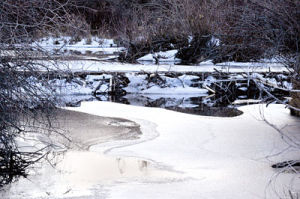A friend posted this 1927 technical bulletin from USDA on the beaver management facebook group Bailey beaver habits 1927. It was written by Vernon Bailey who was a biologist for their Investigation Bureau. There was some usual bunk about beavers causing troubles and a big discussion of how to manage them on farms, but there were unexpected tidbits I think you’ll really appreciate.
 In case you can’t read the caption it says “Baby beavers are gentle and affectionate. These animals would be delightful playmates for children if they did not sleep most of their day and carry on their activities mostly at night”. No kidding!
In case you can’t read the caption it says “Baby beavers are gentle and affectionate. These animals would be delightful playmates for children if they did not sleep most of their day and carry on their activities mostly at night”. No kidding!
In addition to idly pointing out that baby beavers are sweet, this early bulletin shows some ways to manage beaver conflicts – including wrapping trees ;
The trees cut by beavers for food^ and building material are generally of little value. They are mainly aspens, cottonwoods,birches, and pin cherries, or such shrubby woods as willows,alders, bush maples, hazels, and smaller bushes. Some choice trees,however, are occasionally cut along lake or stream fronts or in orchards near the water, and complaints of real damage and losses are at times registered; but in many cases the trees could be protected with strips of woven wire at a cost of a few cents each and the beavers left unmolested.
And even an early flow device design;
Remember this was published 87 years ago. And not by some crazy beaver lover like me, but by their own biologist. In 2014 USDA is still saying there is no way to manage beavers or control flooding. Even Jimmy Taylor says the issue needs “more research”. When did the I.Q. of beaver management fall off so badly?
But this is the part that made my jaw drop.
It is often charged that beavers interfere with or injure fishing in streams where they build dams, and some persons still believe that they catch and eat fish. There is, however, no evidence of a beaver ever catching, killing, or eating any animal food. Of all captive beavers kept and studied and of young beavers raised, not one has been found that would touch or eat fish or meat in any form.
That beaver dams may in some cases, in slow or sluggish streams,spread out the water over marsh vegetation, forming shallow, warm ponds with decaying plants on the bottom quite unsuited to trout or fish of any kind is well known. Usually, however, such streams are not important fish streams before dammed by the beavers, and in course of time the water is freed from such decaying matter and is as satisfactory for fishes as before.
In cold, rapid streams, naturally well adapted to trout, beaver ponds rarely become sufficiently warm and stagnant to interfere with the comfort of fishes, and in most cases the deepening and extending of the water area above the dam increases the feeding and spawning area,providing deep pools and hiding places where the fishes thrive and escape detection long enough to grow up to larger size. In many streams both in the mountains and over a vast expanse of north country the trout fishing is greatly benefited by the presence of beavers, their dams, and ponds. Large trout and good fishing are commonly found in beaver ponds.
So the frickin’ USDA knew 100 years ago that beavers were good for fish and PEI is still stomping around killing beavers to protect salmon. That’s infuriating. The issues around beaver management are a mobius strip where whenever we think we are done addressing the last concern we find we are right back at the beginning again.
Honestly if you have a free moment, I would go check out the whole thing. Skip through the part about how to kill them or cook them but there’s a very nice passage about beaver vocalizations I’ll share as it made me think of mom.
Old beavers are generally supposed to be voiceless, except for a loud blowing sound made when scared or angry, but one day when photographs were being taken of the old beaver and her six young the young became chilly in the cold spring water, and when their mother was out of sight they began crying and calling for her in distressed tones. Soon from the shade of the other bank where she was lying on the water, she raised her nose slightly above the surface and made several soft mooing notes, like a long o-o-o-o pronounced with the lips closed. At once recognizing the call, the young quickly swam across and climbed up on her back, where they sat, warming their cold toes and tails in her fur and combing the water out of their hair, perfectly contented.


















































